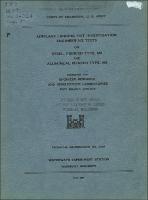Please use this identifier to cite or link to this item:
https://hdl.handle.net/11681/21273Full metadata record
| DC Field | Value | Language |
|---|---|---|
| dc.contributor | United States. Army. Engineer Research and Development Laboratories | - |
| dc.contributor.author | U.S. Army Engineer Waterways Experiment Station | - |
| dc.date.accessioned | 2017-02-15T14:35:00Z | - |
| dc.date.available | 2017-02-15T14:35:00Z | - |
| dc.date.issued | 1951-05 | - |
| dc.identifier.uri | http://hdl.handle.net/11681/21273 | - |
| dc.description | Technical memorandum | - |
| dc.description | Preface: ince the end of World War II, development work has been in progress at the Engineer Research and Development Laboratories on landing mats for planes of the B-29 class. A heavy, deep-ribbed, pierced steel mat, designated M7, designed by the Engineer Research and Development Laboratories, was tested by the Waterways Experiment Station in 1947, and the results reported in Waterways Experiment Station Technical Memorandum No. 3-266, "Airplane Landing Mat Investigation, Tests on Steel, Pierced Type, M7," dated December 1948. As a result of these tests and further study at the Engineer Research and Development Laboratories, the design was modified by the Engineer Research and Development Laboratories and heavy mats, designated MB steel and M9 aluminum, were procured. The steel mat was fabricated by the United Steel Fabricators, Inc., of Wooster, Ohio, in accordance with the Engineer Research and Development Laboratories' drawing M-7613, "Airplane Landing Mat, Steel Pierced Type M-8." The aluminum mat was fabricated by the Reynolds Metals Company at one of their Louisville, Ky., plants. Engineering tests on these mats were authorized by the Engineer Research and Development Laboratories, in accordance with the plan of tests prepared by that agency, by letter dated 18 January 1950. The tests were conducted by the Soils Division of the Waterways Experiment Station during the period 18 January to 1 May 1950. Messrs. George B. Schoolcraft and William B. Spangler of the Engineer Research and Development Laboratories were active in planning the tests. Engineers of the Waterways Experiment Station actively connected with the study were Messrs. W. J. Turnbull, W. K. Boyd, C. R. Foster, and O. B. Ray. | - |
| dc.publisher | U.S. Army Engineer Waterways Experiment Station. | - |
| dc.publisher | Engineer Research and Development Center (U.S.) | - |
| dc.relation | http://acwc.sdp.sirsi.net/client/en_US/search/asset/1049908 | - |
| dc.rights | Approved for public release; distribution is unlimited. | - |
| dc.source | This Digital Resource was created from scans of the Print Resource. | - |
| dc.subject | Landing mats | - |
| dc.subject | Steel | - |
| dc.subject | Aluminum | - |
| dc.title | Airplane landing mat investigation, engineering tests on steel, pierced type, M8 and aluminum, pierced type, M9 | - |
| dc.type | Report | en_US |
| Appears in Collections: | Technical Memorandum | |
Files in This Item:
| File | Description | Size | Format | |
|---|---|---|---|---|
| WES-Technical-Memorandum-No.3-324.pdf | 12.44 MB | Adobe PDF |  View/Open |